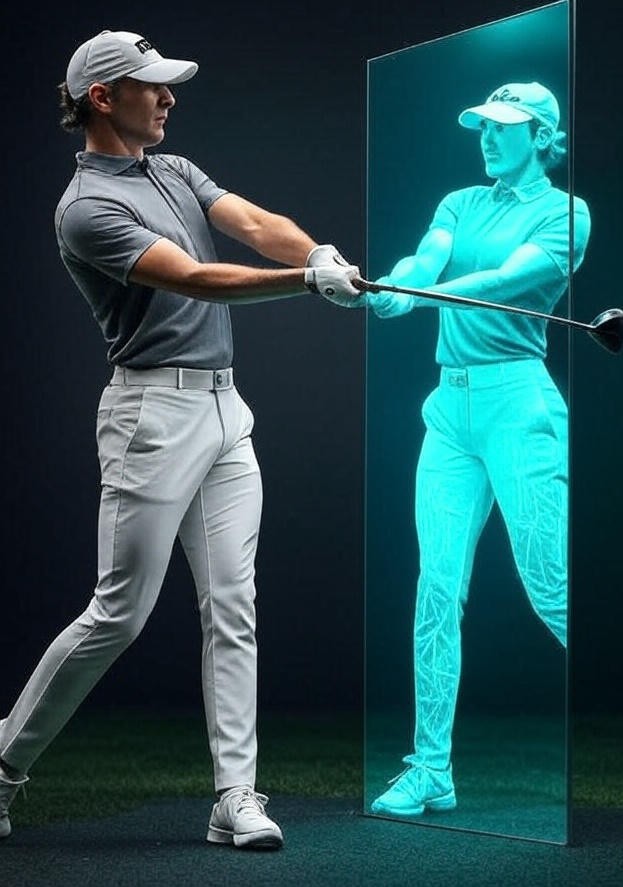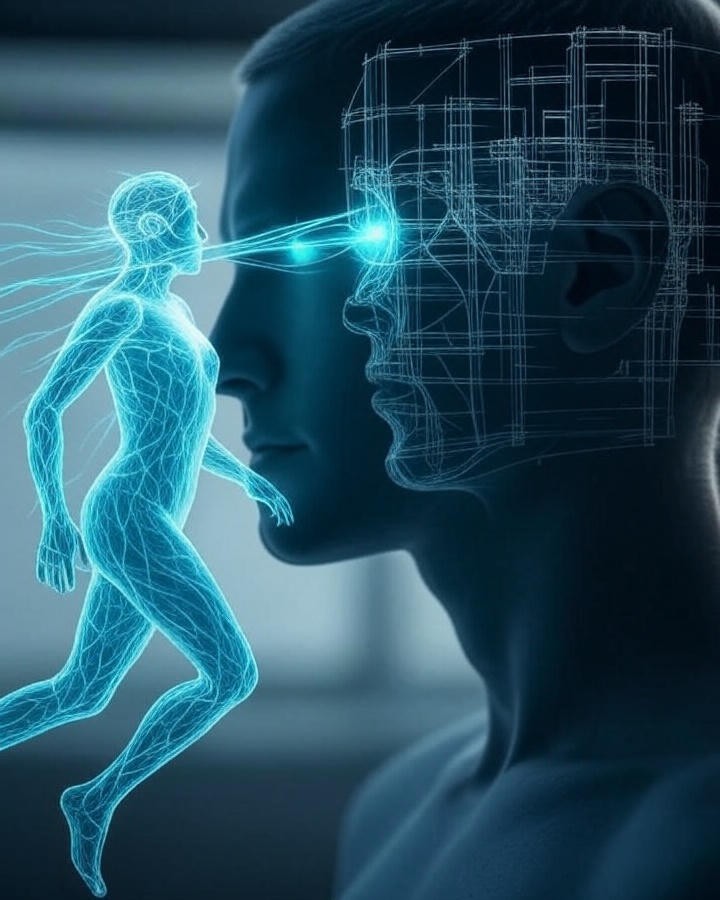Watch a child’s face as they observe their parent. The subtle, unconscious imitation of a smile, a frown, a look of concentration—it’s a universal human experience. Watch a crowd at a sporting event; when a player makes a dramatic, athletic leap, you can see the bodies of the spectators tense and shift in their seats, their own muscles firing in sympathetic resonance.
For centuries, we dismissed these phenomena as simple mimicry or social quirks. But what if they are clues to a profound neurological secret? What if they are the visible output of the most advanced virtual reality simulator ever created—a hidden system in our brain that allows us to practice, learn, and experience the world without ever moving a muscle?
This is not science fiction. It is the reality of one of the most significant neuroscientific discoveries of the past half-century: the mirror neuron system. This network of remarkable brain cells provides the biological foundation for empathy, language, and, most critically for our purposes, a powerful shortcut to the mastery of motor skills.
The pioneering neuroscientist Dr. V.S. Ramachandran called them “the neurons that shaped civilization,” arguing that their emergence was a pivotal event in human evolution. Understanding how to consciously engage this system is like finding a hidden schematic for your own brain. It reveals that the most effective way to learn a new skill may not be to practice it endlessly, but to first observe it perfectly.
This article is a journey into the science of your brain's built-in VR. We will explore the accidental discovery of mirror neurons, delve into Dr. Ramachandran’s profound insights, and reveal how this innate system for observational learning in sports can be systematically harnessed to accelerate your path to mastery.

Part 1: The Accidental Discovery of the Brain's Mirror
The story of mirror neurons begins not with a grand theory, but with a happy accident in a lab in Parma, Italy. In the early 1990s, a team of neuroscientists led by Dr. Giacomo Rizzolatti was studying the brains of macaque monkeys. Their work involved monitoring individual neurons in the premotor cortex—a region of the brain involved in planning and executing actions.
They had identified a specific set of neurons that fired whenever a monkey reached for a peanut. One day, a researcher, holding an ice cream cone, walked into the lab. As he lifted the cone to his own mouth, the monitoring equipment connected to the monkey’s brain, which was sitting perfectly still, suddenly crackled to life. The exact same neurons that fired when the monkey reached for a peanut were now firing as it simply watched the human perform a similar action.
The team was initially baffled. As Rizzolatti later recounted, their first thought was that the equipment was malfunctioning. But after rigorous testing, the conclusion was inescapable. They had discovered a new class of brain cells that did not distinguish between seeing and doing. These “mirror neurons” were activated both when the monkey performed an action and when it observed the same action being performed by another.
It was a monumental discovery. The brain, it turned out, had a built-in virtual reality simulator.
Part 2: V.S. Ramachandran and "The Neurons That Shaped Civilization"
While Rizzolatti’s team made the initial discovery in monkeys, it was Dr. V.S. Ramachandran who became the great popularizer and theorist of the mirror neuron system’s profound implications for humans. He argued that this was not a minor neurological quirk, but the very foundation of human culture and consciousness.
Ramachandran’s central thesis is that mirror neurons solve two of the most complex problems in neuroscience: understanding another person’s actions and imitating them.
Before the discovery of mirror neurons, the prevailing theory was that understanding someone’s actions was a purely intellectual process. You saw someone reach for a cup, and your brain would run a series of logical deductions: “He is reaching, his hand is forming a grasping shape, there is a cup there, therefore he intends to drink.” Ramachandran argued that the mirror neuron system provides a far more elegant and direct solution. When you see someone reach for a cup, your mirror neurons fire and create a simulation of that action in your own brain. You understand the action because, in a very real sense, you are experiencing it yourself.
This is the neurological basis of empathy. When you see someone smile, your mirror neurons for smiling fire, triggering a cascade of associated emotions in your own brain and allowing you to feel a shadow of their joy. When you see someone accidentally hit their thumb with a hammer, you physically wince. That wince is not just sympathy; it’s your brain’s mirror system running a low-level simulation of the pain, allowing you to understand the feeling without having to endure it.
This same system is the engine of imitation, which is the cornerstone of motor learning. A child doesn't learn to wave goodbye through a series of verbal instructions. They watch, their mirror system fires, and it creates a template that their motor system can then attempt to replicate. This is why how to learn skills by watching is not a passive activity; it is an active neurological event.
As Dr. Ramachandran famously proposed, this ability to simulate and replicate actions is what allowed skills and knowledge—the use of tools, the control of fire, the development of language—to spread horizontally through the human population like a benevolent virus. It is, in his words, the cultural "great leap forward."

Part 3: From Blueprint to Body: The Science of Motor Resonance
The implications of the mirror neuron system for athletes and performers are staggering. It means that every time you watch an elite athlete perform, you are doing more than just passively observing. Your brain is actively engaging in a form of practice.
This phenomenon is known as “motor resonance.” When you observe a movement, your own motor cortex—the part of your brain that controls your muscles—becomes active in a way that “resonates” with the action you are seeing. This has been verified in numerous studies using Transcranial Magnetic Stimulation (TMS), a technique that can measure the excitability of the motor cortex. Research has consistently shown that observing an action, such as a finger movement or a golf swing, leads to a significant increase in excitability in the specific part of the observer's brain that controls those same muscles.
Your brain is creating a high-fidelity neural blueprint of the skill. It’s building the software before you’ve even tried to run the hardware. This is a critical insight that reframes the entire learning process, a concept we touch on in our article, "The Plastic Brain: How to Rewire Your Mind for Faster Skill Acquisition."
However, this system has a critical limitation. The blueprint is only as good as the model you observe, and simply having the blueprint is not enough. You must be able to translate that perfect neural map into an accurate physical feeling. This is the gap where most learning breaks down. You can watch a thousand perfect golf swings, but if your own proprioceptive system—your internal sense of where your body is in space—is uncalibrated, you will be unable to physically replicate the pattern your brain has learned. This is the core challenge we deconstruct in "The Talent Myth: Why You Aren't 'Athletic'."
To achieve true mastery, you need a system that can both provide a perfect model for your mirror neurons to copy and then provide the objective, real-time feedback needed to bridge the gap between that internal blueprint and your physical execution.

Part 4: A System for Hacking the Mirror
The GOAT Platform is engineered from the ground up to be a systematic application of these neuroscientific principles. It is a two-stage engine designed to first intentionally activate your mirror neuron system with a flawless model and then provide the tools to make that model a physical reality.
Stage 1: Installing the Perfect Blueprint
The process begins by providing your brain with the ideal stimulus for observational learning. Through our proprietary accelerated learning protocol, the system guides you into a state of heightened neuroplasticity and presents a neurologically optimized model of the perfect movement.
This is not the same as watching a clip on the internet. The model is presented in a way that is specifically designed to maximize motor resonance. By controlling variables like speed and focus, we ensure that your mirror neuron system can deconstruct the movement and build the most accurate, high-fidelity neural blueprint possible. In a session of just a few minutes, your brain is pre-loaded with dozens of perfect repetitions, carving the ideal pathway and beginning the process of myelination before you’ve taken a single swing.
The power of this structured observational learning is not just theoretical. A PhD study conducted with a competitive high school swim team validated this exact methodology. Over an 8-week season, the swimmers using the audio-visual learning system improved their personal best times by 3.5% more than the control group who relied on traditional coaching alone. This statistically significant result demonstrates that this form of neuro-priming creates more efficient movement patterns and measurably accelerates progress.
Stage 2: Bridging the Gap from Blueprint to Body
Once the perfect neural map is installed, the second stage of the engine comes online: the sensor system. This is the crucial link that translates the blueprint into a calibrated physical skill.
As we detail in our article, "Beyond Replay: Why Video Analysis is a Map of the Past," the immediacy of feedback is paramount for effective learning. The GOAT sensors provide this link by offering objective, real-time data on your movement. This creates a powerful feedback loop:
- Observe: Your brain learns the perfect pattern through the accelerated learning protocol.
- Execute: You attempt the physical movement.
- Calibrate: The sensors provide immediate, unbiased feedback, allowing your brain to compare the internal blueprint to the external reality.
With each repetition, you are systematically closing the gap between what you saw and what you did. You are training your proprioceptive system to align with the perfect model stored in your brain. While the learning component alone has been validated to accelerate progress, it is the combination of this neuro-priming with the hyper-efficient refinement from our sensor system that creates a synergistic effect, forming the basis of our 20x Hypothesis for a potential 15-20x acceleration over traditional methods.
Conclusion: You Are Hardwired for Mastery
The discovery of mirror neurons is a profound gift. It is a revelation that the ability to learn is more deeply embedded in our biology than we ever imagined. We are not just individuals, struggling in isolation to acquire skills; we are deeply interconnected beings, equipped with a powerful neural architecture that allows us to learn from the excellence of others.
The work of visionaries like V.S. Ramachandran has given us the map. We now understand that your brain is not a passive spectator but an active participant in every movement you observe. It is constantly running simulations, building blueprints, and preparing itself for action.
This is the end of the belief that practice must always be a long, arduous process of physical trial and error. We now know that the most efficient path to mastery is to first provide the brain with a perfect model, allowing it to build the neural superhighway before the traffic arrives.
The capacity for greatness is not a gift bestowed upon a few. It is a fundamental component of your brain’s design. You are already hardwired for mastery. You just need to learn how to turn on the mirror.
